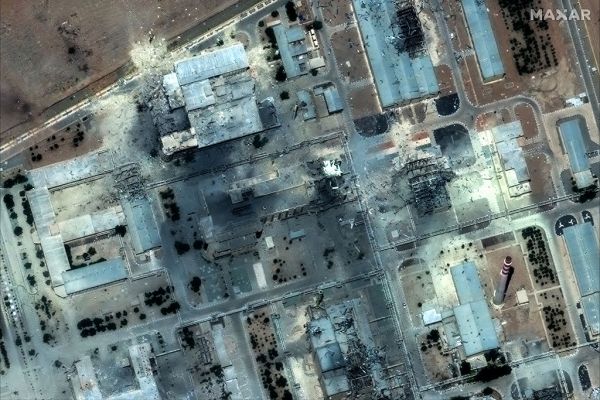Happy Monday! We here at TMD are into fitness and cute animals, and thus, we were delighted to come across the Instagram account, pandsfitness, where Pierson demonstrates how to perform lifts with the correct form, while using his fluffy cat, Hopper, as the demonstration weight. This is what the internet was made for.
Quick Hits: Today’s Top Stories
- FBI agents searched the Maryland home and Washington, D.C., office of former National Security Adviser John Bolton on Friday morning, reportedly as part of an investigation into his potential mishandling of classified documents. Bolton was not charged or detained during the operation. President Donald Trump—who revoked Bolton’s security clearance and Secret Service protection days into his second term—told reporters he had no prior knowledge of the searches but described Bolton, who has been a sharp critic of Trump in recent years, as “a real sort of a low life” and “not a smart guy.” It’s unclear what specific documents prompted the search warrant, though NBC News reported the intelligence that served as the basis for the search warrant came from CIA Director John Ratcliffe, and he shared it with FBI Director Kash Patel. “NO ONE is above the law,” Patel tweeted on the morning of the raid. “FBI agents on mission.”
- Canadian Prime Minister Mark Carney announced on Friday that Canada would eliminate retaliatory tariffs on American goods that comply with the U.S.-Canada-Mexico Agreement (USMCA), effectively restoring free trade for the majority of products traded between the two nations. Both countries will maintain their tariffs on steel, aluminum, automobiles, and other strategic sectors, but tariff negotiations are ongoing. Carney, speaking on Friday, said that while Canada’s trading status with the U.S. is “different from what we had before,” it’s “still better than that of any other country,” and claimed that Canadian goods face an average U.S. tariff rate of just 5.6 percent. Trump told reporters Friday that he and Carney “had a very good call,” and that “we want to be very good to Canada.”
- In a Friday Truth Social post, Trump announced that the federal government would take a 10 percent stake in Intel, the tech company and computer-chip maker, as a conversion of $11.1 billion in previously granted funds and pledges. The government received the 433.3 million non-voting shares at $20.47 each, representing a significant discount on their Friday closing price of $24.80. The government will not hold a board seat or participate in any official decision-making positions within the company. An unnamed White House official told the New York Times that the American economy’s reliance on semiconductor chip production warranted the federal government’s direct involvement in a private company.
- Federal Reserve Chairman Jerome Powell hinted in a speech on Friday that the central bank could cut interest rates at its policy meeting next month, citing a cooling economy and labor market. Powell cautioned that, while “upside risks to inflation had diminished,” gross domestic product (GDP) growth “has slowed notably” in the first half of 2025, and tariffs have “begun to push up prices” for certain goods. Trump has repeatedly urged the Fed to lower interest rates, which the bank last did in December 2024. Powell said any decision will be made solely on the “assessment of the data and its implications for the economic outlook and the balance of risks,” adding that “we will never deviate from that approach.”
- The Israel Defense Forces (IDF) hit Yemen’s capital city, Sanaa, with airstrikes on Sunday, targeting the Houthis in retaliation for a cluster bomb attack that the Iranian-backed terror group fired into central Israel on Friday. According to the IDF, Israel’s strike targeted a military complex near Yemen’s presidential palace, a fuel depot, and two power stations. The Friday Houthi attack caused no injuries or fatalities, but the IDF is investigating how defense systems failed to intercept the cluster bomb, stating that its air defenses “are capable of dealing with and intercepting such missiles.”
- The Justice Department released transcripts on Friday of interviews Deputy Attorney General Todd Blanche conducted last month with Ghislaine Maxwell, the convicted child sex trafficker and accomplice of Jeffrey Epstein. Maxwell told Blanche she never witnessed any inappropriate behavior from Trump and that he had no involvement with Epstein’s crimes, calling him “a gentleman in all respects.” She said she did not believe former President Bill Clinton engaged in illegal behavior either, and that neither president visited Epstein’s private islands. Maxwell also denied the existence of Epstein’s alleged “client list.” At the beginning of the month, when asked about pardoning Maxwell, Trump denied having any knowledge of her case and said, “I’m allowed to do it, but nobody’s asked me to do it.”
- Federal immigration officials plan to deport Kilmar Abrego Garcia—the El Salvadoran national mistakenly deported by the Trump administration to El Salvador’s maximum security prison—to Uganda, his defense attorneys stated in court filings on Saturday. They wrote that Immigration and Customs Enforcement officers informed them of plans to deport Abrego Garcia to Uganda after he rejected a plea deal for federal human smuggling charges, in which—after serving his sentence for those charges in U.S. detention—he would be deported to Costa Rica, where he would be free from further detention. Abrego Garcia’s lawyers claimed that the government gave him until Monday morning to accept the plea deal, after which “that offer will be off the table forever.” When Abrego Garcia returned to the U.S. in June, Attorney General Pam Bondi announced fresh federal charges against him. Abrego Garcia pleaded not guilty in June, and requested that the case be dismissed.
- The Wall Street Journal reported on Saturday that the Pentagon has restricted Ukraine’s ability to fire U.S.-supplied long-range Army Tactical Missile Systems to strike targets within Russian territory, reversing a November 2024 action from former President Joe Biden. Citing unnamed officials, the Journal reported that Elbridge Colby, the under secretary of defense for policy, implemented a “review mechanism” for requests from Ukraine to use the U.S.-supplied missiles—or other strikes relying on U.S. intelligence—for attacks inside Russia. Defense Secretary Pete Hegseth reportedly has the “final say” over that authorization. Meanwhile, Russia hit Ukraine with another large-scale overnight attack late on Thursday, launching 574 drones and 40 missiles, per Ukraine’s air force. At least one civilian was killed and three others injured in the western Ukrainian city, Lviv, which, because of the city’s proximity to the Polish border, prompted North Atlantic Treaty Organization forces to scramble fighter jets.
Can Iran Still Build an Atomic Bomb?

According to President Donald Trump, the United States’ June strikes on Iran’s nuclear sites and military installations were devastating. Over the course of the 12-day war, in which Israeli forces targeted Iran directly, top Iranian nuclear scientists were assassinated by drones, Iranian air defenses were systematically knocked out, and uranium enrichment sites at Fordo and Natanz—built underground and beneath dozens of meters of concrete—were buried underneath craters left by U.S. MOPS (mass ordnance penetrators—a.k.a. really big bombs).
In his “Address to the Nation,” on June 21, Trump said that “Iran’s key nuclear enrichment facilities have been completely and totally obliterated.” According to the White House, Operation Midnight Hammer was a complete success and, seemingly, set the Iranian nuclear threat back years, if not indefinitely.
But questions quickly emerged over whether the administration was overstating the case. According to a July intelligence report, Iran’s deep underground facility at Fordo was badly damaged, but the secondary targets—at Isfahan and Natanz–could be operational again within months, if the Iranians so chose. And if the regime’s behavior in recent weeks is any indication, its nuclear ambitions were not buried beneath the rubble with many of its facilities.
After engaging in months of talks earlier this year, Iranian leaders cut off nuclear talks with the U.S. indefinitely, and they have ended the country’s cooperation with the International Atomic Energy Agency (IAEA). Officials from the IAEA, an intergovernmental organization that monitors the potential development of nuclear weapons, will travel to Washington this week to discuss next steps with the U.S., following a refusal by Iran to allow inspectors to resume the monitoring scheme that existed before the Iran-Israel war. Iran maintains that the sites of the strikes remain too dangerous to visit, but officials in Tehran have long expressed their distrust of the IAEA.
“We have not reached the point of cutting off cooperation with the Agency,” Iranian foreign minister Abbas Araghchi claimed, referring to IAEA, “but future cooperation will certainly not resemble the past.”
“Our policy is clear: we do not seek nuclear weapons,” Araghchi said in a recent interview with Iranian state television. “But we do insist on our right to enrichment for peaceful purposes, as well as to preserve the scientific achievements we have made independently.” He claimed that recent U.S. strikes were driven by a belief that Iran should halt all uranium enrichment, rather than Israeli and U.S. intelligence indicating that Iran was nearing the ability to build a bomb.
Before the strikes by Israel and the United States, Iran had two primary uranium enrichment sites: Natanz, in the centrally located province of Isfahan, and Fordo, situated to the north outside of the city of Qom. Most experts agree that both sites were substantially damaged by the combination of Israeli strikes and U.S. follow-up attacks. Bombers also struck the Isfahan Nuclear Technology Center, which possessed the ability to convert yellowcake into gaseous uranium hexafluoride (UF6), which could then be enriched in centrifuges and converted into a metal for use in nuclear warheads.
Satellite imagery at all three sites shows that the Iranian government hasn’t made much of an effort to repair facilities or to resume operations, and the strikes were clearly a significant setback for the country’s nuclear ambitions. However, two big question marks hover over a mysterious facility located beneath the ominously named Pickaxe Mountain, near Natanz, and the possible existence of a new nuclear site in Isfahan.
Pickaxe Mountain was not targeted in the June strikes and remains active according to satellite imaging. Some experts believe that it may house not only centrifuges and the machinery for constructing them, but possibly Iran’s remaining stockpile of near-weapons-grade uranium.
Meanwhile, in June, IAEA Director Rafael Grossi said that Isfahan was the site for a new uranium enrichment facility. Days before the initial Israeli strikes, Iran had announced that it would be opening the new facility in retaliation for the IAEA declaring the country to be in breach of its non-proliferation obligations. It’s unclear whether Iran has brought this site online yet, or if it plans to do so soon.
But even if Iran has, at least temporarily, lost the ability to manufacture weapons-grade uranium, it likely still possesses nearly a thousand pounds of highly enriched uranium. Only a few days into the June war, the IAEA said it lost track of the 902 pounds of highly enriched uranium known to regulators, and though U.S. Vice President J.D. Vance told Fox News that this stockpile had been “buried” in the strikes, satellite images from before the attack seem to indicate that the material was rapidly moved ahead of time.
If that uranium remains accessible to Iran, it’s quite possible to turn it into nuclear warheads. “Getting from 60 to 90 percent enrichment is a lot easier than getting from zero to 60,” Joseph Rodgers, a deputy director and fellow for the Project on Nuclear Issues at the Center for Strategic and International Studies, told TMD. “It only takes a few weeks with a decent centrifuge cascade.” If Iran is able to recover some centrifuges, and then pursue clandestine enrichment, it would have enough weapons-grade uranium to make roughly 10 nuclear bombs, Rodgers said.
However, even in the event of an all-out sprint for a bomb by the Iranian state, substantial obstacles, other than the ability to enrich enough uranium quickly enough, remain. First, Rodgers noted, nuclear bombs are more than enriched uranium. They also need to be delivered by missile or plane, and Iran does not clearly have the capability to construct large, accurate missiles that can penetrate air defenses.
Iran’s impotence in striking adversaries in recent months has demonstrated how relatively weak the country’s missile program is, Rodgers noted. “Iran needs to step up their missile program in order to effectively deliver a hypothetical nuclear weapon,” he argued. Of the more than 1,000 drones and hundreds of ballistic missiles launched at Israel by Iran during the 12-day war, Israel and the U.S. were able to intercept more than 90 percent of them, according to Israel. With its missile batteries severely damaged by U.S. and Israeli strikes, Iran’s ability to strike faraway targets is even more limited today.
Second, Israeli intelligence services were able to assassinate important members of the group of scientists underpinning Iran’s nuclear program. According to Israeli Ambassador to France Joshua Zarkas, at least 14 top scientists were killed by Israel during the country’s June strikes. “The fact that the whole group disappeared is basically throwing back the program by a number of years,” he declared. Replacing that technological know-how is certainly possible, but it will take time.
It will also take quite a bit of money. “Iran’s budget isn’t [an infinite] pie,” Michael Rubin, a Dispatch contributor and senior fellow at the American Enterprise Institute, told TMD. With the recent decline in the price of oil, exports of which make up roughly 35 percent of total revenue in Iran’s budget, the trade-offs are likely to become relatively stark. “The ayatollahs either can provide electricity, water, and a relatively stable currency, or they can invest in their enrichment and missile programs,” Rubin said. On Sunday, Khamenei called his country’s conflict with the U.S. over its nuclear program “unsolvable.”
We’ll have more clarity on whether Iran really has given up on complying with the West in the coming weeks. On Friday, Iran’s foreign minister spoke with Germany, France, and Britain as the three European nations threatened to impose “snapback” sanctions on Tehran by the end of the month. “We have just made an important call to our Iranian counterpart regarding the nuclear program and the sanctions against Iran that we are preparing to reapply,” French Foreign Minister Jean-Noël Barrot said. “Time is running out.”
Today’s Must-Read

La Vie en Commune
Toeing the Company Line

Supporting Your Kids Is Not the Same as Coddling



Bolton Raid: Legitimate Investigation or Political Retribution?

How Parents Can Bridge the Reading Gulf

10 Phrases I Pretended to Understand as a D.C. Intern

On Smoking, and Other Human Vices

The New Three Legs of Conservatism | Interview: Matt Lewis

Cash and Character | Solo
Worth Your Time
- In the Rising Tide Substack last month, Miranda Bogen—head of the AI Governance Lab at the Center for Democracy & Technology—wrote about how personalized artificial intelligence, which stores previous chats with and personal details about users, risks repeating the worst aspects of social media. “I’ll admit, it would be easier if AI models did have access to all my prior work, calendars, texts, and the contents of my fridge,” she wrote. “But as the appeal of personalized systems grows, the amount of data that will accrue to companies—many of them relatively young institutions with nascent infrastructure to manage user data—is substantial. That is where perverse incentives begin to take root. Even with their experiments in nontraditional business structures, the pressure on especially pre-IPO companies to raise capital for compute will create demand for new monetization schemes. Against such powerful commercial incentives (and in the face of largely dismantled consumer protection regulators), users will have negligible protections against AI companies leveraging all the data they will have collected to shape user behavior as they please, whether to purchase sponsored products, shift towards favored political views, or to squeeze every last drop of engagement and attention out of users without regard to the externalities. Even if AI companies stay away from ad-driven models, personalization is incredibly appealing for companies as a way to increase ‘stickiness,’ or tether users to their ecosystem.”
- Sticking with the AI theme, Tyler Cosgrove—a physics student at the University of Michigan—published a blog that, while ostensibly about which AI model has the best taste in music, may have also revealed a previously unknown bias in reasoning models. “I felt that asking models for a list of their top 10 favorite artists or something would be too heavily influenced by various charts and lists online, so I chose a bracket-style approach instead: the model picks between two artists, and the winner advances to the next round,” he explained. “Something odd is clearly happening with some of the reasoning models (see: o3, gpt-5, grok-4, deepseek-r1). As funny as it would be for Grok-4 to love $uicideboy$ and 100 gecs, basically all of the artists on these lists start with numbers or dollar signs, which points to the idea that the labs went a little too hard on the RL [reinforcement learning]. This seems like a fairly major flaw? Perhaps it’s reasonable to say that RL is making the models much spikier, and spikier in ways we might not want. It’s also interesting that this happens with not just OpenAI, but Grok and DeepSeek too.”
Presented Without Comment
Washington Post: Pentagon Plans Military Deployment In Chicago As Trump Eyes Crackdown
The Pentagon has for weeks been planning a military deployment to Chicago as President Donald Trump says he wants to crack down on crime, homelessness and undocumented immigration, in a model that could later be used in other major cities, officials familiar with the matter said.
The planning, which has not been previously disclosed, involves several options, including mobilizing at least a few thousand members of the National Guard as soon as September to what is the third most populous city in the United States.
Also Presented Without Comment
The Journal (Ireland): 6 Foot 5 Justice Minister Says He Feels Safe Walking Around Dublin ‘Any Time of the Day or Night’
Also Also Presented Without Comment
The Telegraph: Daily Mail Owner Calls for Crackdown on Google AI After Traffic Tanks
The owner of the Daily Mail has called for a crackdown on Google’s artificial intelligence (AI) after warning that early tests of the technology in search were causing web traffic to crater.
DMG Media has written to the Competition and Markets Authority (CMA) saying that the search giant’s “AI overviews” were leading readership from Google searches to fall by as much as 89pc.
Let Us Know
Have any thoughts or questions about today’s newsletter? Drop us a note in the comments!










Please note that we at The Dispatch hold ourselves, our work, and our commenters to a higher standard than other places on the internet. We welcome comments that foster genuine debate or discussion—including comments critical of us or our work—but responses that include ad hominem attacks on fellow Dispatch members or are intended to stoke fear and anger may be moderated.
With your membership, you only have the ability to comment on The Morning Dispatch articles. Consider upgrading to join the conversation everywhere.